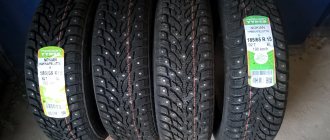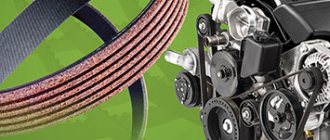Very often the question arises about the interchangeability of Dextron II and Dextron III. There are two opinions on this matter:
• Dexron III is the same as Dexron II, but with improved characteristics, and if you mix it with Dexron II, nothing bad will happen. In general, the ATF that can be poured into the machine should be no lower than that indicated on the dipstick. That is, if Dexron II is indicated on the dipstick, then both II and III (and higher) can be poured, but if III is indicated, then II cannot be poured. • Since the characteristics of Dexron III still differ from the characteristics of Dexron II, this may affect the operation of the automatic transmission, and not for the better. II and III differ in viscosity, and significantly, and this greatly changes the pressure in the automatic transmission system, which plays a big role in the operation of the box. • Conclusion, it is recommended to fill only what is indicated on the dipstick or in the car’s instructions. Variations are possible only with respect to the manufacturer. Otherwise, over time, experiments with mixing Dexron may have a detrimental effect on the automatic transmission of your car.
In this case, it is necessary to take into account several nuances. For example, when choosing an ATF, its color should in no way be the deciding factor. The color of ATF depends only on the dye and is needed for quick identification. It also does not matter what type of oil - synthetic or mineral. Unlike an engine, in an automatic transmission you can mix mineral water with synthetics without detrimental consequences for the operation of the machine. And you need to remember that some automakers (for example, Honda and Mitsubishi) strongly recommend using not just any oil in automatic transmissions, but only special fluids, otherwise normal operation of the automatic transmission is not guaranteed by the manufacturer.
Hydraulic power steering is designed to make steering easier, as well as dampen vibrations and shocks that occur on the steering wheel. In order for it to last a long time and work stably, it is necessary to regularly change the oil in it and monitor its quality. The article discusses Dextron oils, including Dextron 3 for power steering, and gives their description, advantages and disadvantages.
Dextron II and Dextron III
I am very often in the process of working, etc.
I am faced with the issue of interchangeability of Dextron II and Dextron III. What is this? Dextron is the brand name for a group of automatic transmission performance products created by General Motors (GM), established in 1968. Dextron=Automatic transmission fluids (ATF). Automatic gearboxes (hereinafter referred to as automatic transmissions) use a special fluid, which is often called oil - ATF. Historically, the legislator in the field of setting standards in the field of automatic transmission fluids has been General Motors (GM), whose specifications are used by both ATF and automatic transmission manufacturers. So, in the 80s, the current GM specification was Dexron IID, which was then replaced by Dexron IIE, and in 1993 by Dexron III.
Based on interchangeability, dexrons are grouped into groups, depending on equipment requirements:
Dexron III replaces Dexron II (but not vice versa) if the equipment allows for an increase in friction-reducing modifiers. This includes GM automatic transmissions. Dexron III does not replace Dexron II unless the equipment allows for a reduction in the coefficient of friction by increasing the effectiveness of the modifiers.
Dexron IIE replaces Dexron IID on any equipment (but not vice versa), since it does not differ in the effectiveness of modifiers and is actually Dexron IID, but with improved low-temperature properties. And practice
You will have to choose between Dexron IIE and Dexron III as they have more suitable low temperature viscosities. From here, it would seem, a logical conclusion follows for owners of cars with automatic transmissions who use Dextron II and live in “frosty” latitudes - they should “use” Dextron IIE. However, there may be a problem here, which is that the current specification is Dexron III, and all ATF manufacturers are focused on mass production of Dexron III. And for older cars they continue to produce Dexron IID. Why IID and not IIE? Because Dexron IIE is really needed only in the northern regions (where the bulk of the machines are not concentrated at all), and its production (let me remind you that it is a completely synthetic product) costs 2-3 times more. In other words, it makes economic sense for the ATF manufacturer to divide the entire fleet of vehicles into those who need Dexron IID and those who need Dexron III. As a result, buying a Dextron IIE can be a real problem. The transition point from II to III is usually taken as 1996. Here they (manufacturers) are well helped by the fact that GM allows the replacement of Dexron II with Dexron III. It turns out that we can safely recommend Dexron III to those who need good low-temperature properties instead of the “native” Dexron II. Is it really? It's hard to say for sure. Here everyone decides for himself. I will give only the possible consequences of replacing Dexron II with Dexron III in the case when the equipment does not allow a decrease in the friction properties of ATF:
an increase in gear shift time, that is, the gearbox will become more “thoughtful”, because the discs will slip longer than intended by the manufacturer due to the reduced friction properties of Dexron III. jerky nature of gear engagement - that is, the discs slipped and slipped due to the reduced friction properties of Dexron III, and then, as the fluid pressure increased, bam and “seized”.
1. Information, as a rule, is often indicated on the automatic transmission dipstick 2. You can verify the correct choice with the help of technical documentation and manuals for a specific car of a specific year. 3. Dextron II and III differ in viscosity and friction properties. 4. As a rule, Dextron II is poured into “middle-aged” cars, and Dexron III into more modern ones (BUT again, see points 1 and 2)
Source
GINGERBREAKERS GIVEAWAY
So, let's see what happened. It immediately caught my eye that the effect of the fluid brand on the friction coefficient was very ambiguous. For the gearing model, all differences were within the measurement error limits. The Dutch NGN Universal ATF looks a little better than others. But for the bearing model everything is different - the range of the measured parameter is quite large. The best performance here is found in Motul Multi ATF and Castrol ATF Multivehicle fluids.
How critical is the difference in this parameter? On the scale of the entire power unit (engine and gearbox), the share of friction losses in the box is not so large (if you do not take into account losses in the torque converter). But the heating of the oil from friction when operating on different fluids varies much more significantly: the average cumulative difference for the gear and bearing models is approximately 17%. From the point of view of the temperature effect, this difference is very noticeable - up to 10–15 degrees, which gives a change in the efficiency of the torque converter by a noticeable few percent. Motul synthetics look better than others here. NGN Universal and Totachi Multi-Vehicle ATF fluids are only slightly inferior to it.
Heating a liquid also affects its viscosity: the greater the heating, the lower it is. And with a drop in viscosity, the efficiency of the torque converter decreases. Many people remember problems with the “automatic machines” of not very young “French” cars, when due to the increase in fluid temperature (especially in summer in traffic jams) they refused to work at all!
Go ahead. It is very important that the dependence of viscosity on temperature is as flat as possible. One of the main criteria for this flatness is the viscosity index: the higher it is, the better. The leaders here are Mobil Multi-Vehicle ATF, Motul Multi ATF and Formula Shell Multi-Vehicle ATF. The “cartoon” of the NGN brand was not far behind them.
Let's see how much the viscosity of the liquid in the working area of the box changes, taking into account its heating. The difference is noticeable! For kinematic viscosity it reaches 26%. And the efficiency of “automatic machines” (especially older designs) is quite low and is largely determined by the efficiency of the torque converter - which is precisely what suffers when the viscosity of the working fluid decreases.
The smallest drop in viscosity was found for Motul Multi ATF, Formula Shell Multi-Vehicle and NGN Universal ATF oils. The highest is with Totachi Multi-Vehicle ATF. These are, of course, comparative results; direct transfer to the efficiency of the box cannot be made. But for forced engines, in which the load on the automatic transmission components is higher, it is preferable to have fluids with more stable characteristics.
Low-temperature properties were assessed using a combination of several parameters. Obviously, all liquids, including ATF, thicken in the cold. This means that with a significant minus overboard, excessive viscosity will interfere with cranking the engine at the start, since cars with automatic transmissions do not have a clutch pedal. Therefore, we determined the kinematic viscosity of each sample at three fixed negative temperatures. In addition, we estimated the temperature at which the kinematic viscosity of the oil will reach a certain fixed value, conventionally accepted as the limit at which it is still possible to “crank” the gearbox.
Useful article about ATF fluid (many letters)))
1. A little theory and history. Automatic transmissions for FHI cars are made by JATCo, founded as a joint venture between Mazda, Nissan and Ford. Since 1999, JATCo has been owned entirely by Nissan, so it is often said that Subaru has Nissan gearboxes. The automatic transmission has electronic control and an actuator hydraulic mechanism, i.e. Electronically controlled solenoids and ATF (Automatic Transmission Fluid), which acts on various clutches and brakes, are responsible for engaging a particular gear. The automatic transmission was developed in the mid-to-late 80s and has been modernized and improved since then, but has not undergone fundamental design changes.
— Dexron III replaces Dexron II (but not vice versa) if the equipment allows an increase in friction-reducing modifiers. This includes GM automatic transmissions.
— Dexron III does not replace Dexron II if the equipment does not allow a reduction in the coefficient of friction by increasing the efficiency of the modifiers.
— Dexron IIE replaces Dexron IID on any equipment (but not vice versa), because does not differ in the effectiveness of modifiers, and, in fact, is Dexron ohm IID, but with improved low-temperature properties.
- increase in gear shift time, the gearbox will become more “thoughtful” - the discs slip longer than intended by the manufacturer due to the reduced friction properties of Dexron III
- jerky nature of gear engagement - the discs slipped, slipped due to the reduced friction properties of Dexron III, and then, as the fluid pressure increased, bam and engaged.
It seems to me that the symptoms are quite recognizable for Subaru automatic transmissions. In my opinion, for a working box, these differences are not fatal, i.e. at first they are hardly noticeable, but during operation everything wears out, becomes clogged, and the symptoms become more and more noticeable.
Regarding mixing ATF on different bases. Any oils are mixed absolutely accurately within the limits recommended for a given vehicle. Those. mineral water IID with synthetic IIE. Dexron III is mixed with Dexron II by default unless otherwise specified by the manufacturer.
Source
Speaking about transmission fluids, it should be noted that some automobile manufacturers developed their own tolerances and standards for these oils, which subsequently became generally accepted characteristics for companies specializing in the production of technical fluids for cars. These include the General Motors concern, which back in 1968 released the first transmission fluid for automatic transmissions ATF (Automatic Transmission Fluid) of its cars. The company's marketers gave this product the name Dexron, which became a registered trademark for a group of technical specifications for automatic transmission fluids. Under it, General Motors and other manufacturers of technical fluids still produce transmission oils for automatic transmissions.
The original Dextron fluid has been produced since 1968, but four years later General Motors was forced to stop producing it. There were two reasons: weak technical properties and... protest from environmentalists. The fact is that in the composition of Dextron-B, the manufacturing company used oil from whale sperm, which served as a friction modifier (friction modifier). Since whales are considered an endangered species of wild animals, the Endangered Species Act was passed in the United States in 1973, according to which it was prohibited to use any substances of rare species of flora and fauna in the production of industrial and food products. The second reason is purely technical. Whale oil did not withstand the high temperatures that developed in automatic transmissions produced in the 1970s and lost its essential properties as a friction modifier. Therefore, the management of General Motors decided to develop a different formula for Dextron, without whale oil. So in 1972, a new transmission fluid, Dexron IIC, appeared on the market, which contained jojoba oil as a friction modifier. But this product also turned out to be imperfect: its components caused corrosion of GM automatic transmission cooler parts. To avoid this, corrosion inhibitors were added to the fluid - additives that suppress the appearance of rust on automatic transmission parts and components. Dextron with such additives was called IID, and it entered the market in 1975. As in the case of its predecessor, Dexron IID was far from perfect: the corrosion inhibitor added to its composition provoked the hygroscopicity of the transmission fluid - it actively absorbed water vapor from the air and quite quickly lost its working properties. This is why Dextron IID is no longer used in vehicles with hydraulic systems. A further evolution of Dextron was the liquid labeled IIE, produced from the late 1980s to 1993. The manufacturer added new chemical additives to its composition, which made it possible to avoid the excessive hygroscopicity of Dextron. The differences between Dexron IID and Dexron IIE are their basis: the first is mineral, and the second is synthetic. Due to its synthetic “base”, Dextron IIE has the best performance characteristics - it maintains optimal viscosity at low temperatures and has an extended service life. The year 1993 was marked by the appearance of a new product on the gear oil market - Dexron III.
This was the latest development by General Motors, differing from its predecessor in its improved friction properties and viscosity (at low temperatures it better retained fluidity and the ability to lubricate gearbox components). That is why this ATF is recommended for use in countries where winter temperatures drop below 30 degrees Celsius. This fluid is used today by many automakers when refueling automatic transmissions of their models. The advantage of this transmission fluid is its ability to optimally interact with oils that were previously developed by GM - the same Dextron IID, IIE, IIC and even Dextron-B, and replace them.
In 2005, General Motors introduced a new generation of transmission fluid Dextron - VI, which was specially developed for use in the new six-speed automatic transmission Hydra-Matic 6L80.
In this gearbox, the mechanism for interaction of gear ratios was changed, in which the surfaces of the clutch units mated directly, without an “intermediary” in the form of a rubber buffer. This made it possible to reduce torque losses when transmitting it to the drive axle and to avoid failures when moving from stage to stage. To optimally perform these functions, a transmission fluid was required that had low viscosity, improved lubricating properties, and high resistance to foaming and corrosion. It was the working fluid Dextron VI.
The concern completely switched to this fluid for the automatic transmission of its cars at the end of 2006, although many manufacturers of technical oils still produce the third Dextron, as well as Dextron IID and IIE. GM itself no longer regulates or confirms the quality of operating fluids produced under this standard. The difference between the “sixth” Dextron and the “third” was its lower kinematic viscosity - a maximum of 6.5 centistokes at a temperature of 100 degrees Celsius, while for Dextron III at the same temperature it is 7.5 centistokes. A reduced degree of kinematic viscosity allows the transmission fluid to reduce friction losses, which leads to increased fuel efficiency. Also, this transmission fluid has an extended service life, which is why it was given the term “non-replaceable”. This is incorrect, since Dextron VI is also prone to aging, but it needs to be replaced less often than the same Dextron III (on average, 7-8 years after the start of the car’s operation)
DEXRON Traction Drive Fluid – for mechanisms using toroidal gears. Currently, General Motors engineers are testing this fluid for use in the lubrication systems of continuously variable variators.
Depending on the climatic conditions in which vehicles with automatic transmissions that use Dextron are used as a transmission fluid, General Motors recommends using the following ATF:
Is it possible to mix Dextrons of different composition?
This is one of the most interesting questions for car enthusiasts when it comes to replacing outdated transmission fluid. The original manufacturer of Dextron, General Motors, has issued the following recommendations regarding mixing and interchangeability. It is possible to mix, that is, add “oil” with other technical characteristics to the existing volume of transmission fluid only within the limits specified by the gearbox manufacturer. For example, from mixing mineral Dextron IID with synthetic Dextron IIE, a chemical reaction can occur that will lead to the precipitation of substances (especially additives) that can worsen the performance characteristics of the fluid and harm the components and mechanisms of the gearbox.
But mineral Dextron IID can be mixed with mineral Dextron III, but with an eye on what additives the manufacturer uses in these liquids. After all, if the bases of such ATFs do not conflict, then the additives may react, which will lead to a deterioration in the performance characteristics of the gearbox. Another thing is with the mutual replacement of Dextron transmission fluids: here the manufacturer’s recommendations are clearer. Dexron IID can be replaced by Dexron IIE in any type of transmission, as the effectiveness of their friction modifiers is identical. But the reverse replacement of the “transmission” Dextron IIE with Dextron IID is not recommended. Dexron III can be poured into vehicle transmissions that have already used Dexron II transmission fluid.
But only if the amount of friction-reducing modifiers in the original fluid was less than that of the new fluid. Reverse replacement, that is, a “second” Dextron instead of a “third”, subject to the specified conditions, is prohibited. If the gearbox equipment does not provide for a reduction in the friction coefficient, provided that the manufacturer has increased the efficiency of the modifiers, then Dextron II is not replaced with Dextron III. Operating conditions for Dextron transmission fluids Whatever tolerances the manufacturers of transmission fluids give, we advise you to listen to the recommendations of General Motors engineers and companies that produce automatic transmissions. The most important recommendation that you should focus on is the “transmission type” marking on the automatic transmission oil dipstick. If Dexron III is indicated there, then feel free to fill the system with the third Dextron and only it. Why? Yes, because no one guarantees you adequate operation of the gearbox when switching from the recommended fluid to another. If you pour non-recommended transmission fluid into an automatic transmission, dire consequences can occur. Let's name the most common of them: - the transition from stage to stage may take longer due to slipping of the clutch discs. This is due to parameters different from those recommended by the manufacturer (low or high friction properties of the newly filled ATF).
An increase in gear shift time, so-called “slips,” threatens increased fuel consumption; — violation of the smoothness of gear shifting. Occurs due to an increase in the time it takes for the operating pressure of the transmission fluid to build up. Here, too, the problem is in the frictional properties of Dextrons of different compositions. It can lead to failure of the friction discs, and, as a result, to repair of the automatic transmission. Our advice: follow the recommendations of your car's transmission manufacturer, fill only approved transmission fluid, monitor its condition and change it on time. And there will be no problems with the operation of the automatic transmission.
Source
General Motors' role in creating the first ATF
By the end of the 40s, automatic transmissions had become a common part of cars. And it is not surprising that the first ATF oil for automatic transmissions was created by General Motors specialists. This was the world's first transmission fluid specification. It was called Type A. The liquid was created in 1949. Then GM began to develop transmission oils, and later to classify them and put forward the most stringent requirements for them. Products that were created in General Motots laboratories, due to the lack of competition, have become the international standard for working fluids for any type of automatic transmission.
Selecting automatic transmission fluid and Dexron II/III compatibility - theory, practice and tricks
In the previous entry, I mentioned that Dexron 2 was filled into the automatic transmission instead of the required 3. Actually, the play will then proceed in several acts.
ACT I - Compatibility Theory
I won’t bash anyone who wants to delve into the history of the Dexrons - they can read the full version, for example, here. I will only touch on the issue of compatibility. So, a quote from the Internet:
In terms of interchangeability, dexrons are divided into groups, depending on the requirements of the equipment: - Dexron III replaces Dexron II (but not vice versa) if the equipment allows an increase in modifiers that reduce friction. This includes GM automatic transmissions. — Dexron III does not replace Dexron II if the equipment does not allow a reduction in the coefficient of friction by increasing the efficiency of the modifiers. — Dexron IIE replaces Dexron IID on any equipment (but not vice versa), because does not differ in the effectiveness of modifiers, and, in fact, is Dexron ohm IID, but with improved low-temperature properties.
“But not the other way around”... Why? The answer can be partially given by reasoning logically - if 3 has a higher number of modifiers that reduce friction, then 2 has less, therefore, 2 should be thicker, more viscous in its effect. How might this affect the operation of the equipment? For example, cause unnecessary energy consumption due to the excessive “heaviness” of the working agent, as a result - an increase in temperature, excessive wear of components, and loss of characteristics.
ACT II – The Many Faces of Dexron
What should I put into my automatic transmission? Let's look at the directories:
A very special ATF Special 5D06 needs to be poured! Oh how. And what do they pour, I wonder, into the “sibling”?
And here is ATF 2384K... The boxes are the same, but what is the difference? But nothing, in fact, just the names are different, and even on the websites of sellers of these e-liquids they are listed as analogues.
Well, what is written on the dipstick? It’s absolutely impossible to go wrong here:
There seems to be some clarity. Therefore, 5D06 = 2384K = Dexron III. The only difference is the price. Overpaying is not our thing. My favorite oil manufacturer, Petro-Canada, has a liquid in its cellar for our case, and it’s not an easy one:
I immediately bought a box of 12 liters from the dealer in bulk, so as not to waste time on trifles - it came out to 200 rubles per liter, a total of 2400 per box. All the same, you still need to pour it into the power steering, and it will come in handy. Profit.
ACT III - Harsh Reality
HOW?! How could you pour something wrong into the box, seeing the inscription on the dipstick, and not being convinced of compatibility? Repeated facepalm... Well, oh well - we already have what we have: the box shifts noticeably, sometimes kicks, when coasting in top gear it drops this very gear, after 30-40 minutes of driving the box gets a little “dumb” and the “hairy light bulb” begins to blink » catalyst overheating (I thought it was an automatic transmission overheating lamp, and I was wrong). But judging by the service book, they filled in only 4 liters of enemy fluid...
ACT IV - Our hands are not for boredom
It was decided to thoroughly correct the situation with the help of the correct liquid from the second act. But you can’t just go and change the ATF using the partial replacement method - you have to stick your nose and hands everywhere to see “how things are going” in the sump and in the so-called “strainer,” that is, the automatic transmission mesh filter. But things there needed a little intervention:
To remove the pallet I had to unscrew the cardan. In principle, there were not many shavings after 89,000 miles, and the mesh was clean. I don’t want to believe that the hand-assed muuuuuuck guys who changed the ATF not so long ago did it by removing and washing the pan, and all these shavings ran up some thousand kilometers from driving the Dexron 2. Nope, that would be scary... C'mon, me, mind you!
Now we put everything back, screw everything into place, I see this inscription on the drain plug and laugh:
It's time to pour. After removing the pan and filter, 3 liters came out - that’s how much I fill. I filled it up, started it, and moved the automatic transmission handle back and forth on the spot. I checked the level at the COLD mark:
A lot! But how, after all, the crooked mudaras citizens filled up as much as 4 liters in the service? It’s strange... Everywhere in the manuals and catalogs it is written - 2.2 liters with a partial replacement, but this does not mean removing the pan and filter, and more has drained from them - it turns out that with the removal of the pan you need 2.5-2.6 liters. I had to unscrew the cap and drain 400 ml - the COLD level returned to normal.
Actually, the result: the car became faster. It’s noticeably faster – it picks up from a standstill and spins the gears more. Feels and shifts are softer. The “hairy light bulb” does not light up. After a short period of time, I will carry out a similar procedure again in order to drain even more of the “left” Dexron and replace it with the correct one.
Z.Y. By the way, the “sausage” did not go away in the range of 1500-2000 rpm, but became less noticeable. Let's dig further...
Source
ATP service fluid Dextron (Dexron): types and types, features
ATF Dexron service fluid (Dexron) is a widespread product in the markets of different countries and is actively used by owners of various brands and models of cars. This fluid, which is often also called Dextron or Dextron (and in everyday life these not entirely correct names are used very widely), is the working fluid in automatic transmissions, power steering and other mechanisms and assemblies.
In this article we will look at what Dexron ATF is, where and when it was developed. Also, special attention will be paid to what types of this fluid exist and how the different types differ, which Dextron to pour into automatic transmissions and other units, etc.
Is it possible to fill the power steering with engine oil?
Motor - definitely not, transmission - with reservations. Next we will look in detail why.
To understand whether other oils, such as motor or transmission oils, can be poured into the power steering, you need to know what functions it performs.
The power steering fluid must cope with the following tasks:
The above characteristics are achieved by adding various additives, the presence and combination of which gives power steering oil the necessary qualities.
As you understand, the tasks of motor oil are somewhat different, so it is highly not recommended to pour it into the power steering.
Regarding transmission oil, everything is not so clear; the Japanese often use the same ATF fluid for automatic transmission and power steering. Europeans insist on using special PSF (Power Steering Fluid) oils.
Types and types of Dexron liquids
Let's start with the fact that today you can find fluids ranging from Dexron 2, Dexron IID or Dexron 3 to Dexron 6. In fact, each type is a separate generation of transmission fluid, widely known as Dexron. The development belongs to the concern General Motors (GM), which in 1968 created its own transmission fluid for automatic transmissions, Dexron.
The reason is that the first generation actively used whale oil as a friction modifier, and the transmission oil itself on this basis quickly became unusable due to high heat in the automatic transmission. A new formula was supposed to solve the problems, which became the basis of Dexron IIC.
In fact, whale oil was replaced with jojoba oil as a friction modifier, and the product's heat resistance was also improved. However, with all the advantages, the composition had one serious drawback - severe corrosion of automatic transmission elements.
For this reason, they quickly stopped using Dexron IID, releasing the product Dexron IIE, filled with active additives that work against moisture and corrosion. It is noteworthy that this generation of liquid has become semi-synthetic.
Moreover, having convinced itself of its effectiveness, after a short period of time the concern released a fundamentally new liquid with improved performance characteristics. First of all, while earlier generations were mineral or semi-synthetic based, the new Dexron 3 ATF was made from a synthetic base.
Moreover, the manufacturer positions such a liquid as a composition that does not require replacement. In other words, such oil is poured into the automatic transmission for the entire service life of the unit.
As for GM, the corporation is not responsible in any way for the quality and properties of fluids of previous generations, although they continue to be produced according to the Dexron standard. It can also be noted that today Dexron fluids can be standard or HP (high performance) for automatic transmissions that operate in difficult conditions.
There are also Dexron Gear Oils for differentials and clutches, Dexron Manual Transmission Fluid for manual transmissions, Dexron Dual Clutch Transmission Fluid for dual-clutch robotic gearboxes, Dextron for power steering, as well as other units and mechanisms. There is information that General Motors is testing the latest generation of fluid for use as a transmission oil for CVTs.
TOTAL
If during traditional examinations of gasoline and motor oils we, as a rule, identified only minor differences between one sample and another, here the situation is different. In terms of key parameters, the difference between different ATFs turned out to be significant. And if you consider that the degree of influence of this complex fluid on power, fuel consumption, and the resource of the box is very noticeable, then you should think about its choice. Good synthetics with a high viscosity index are the best choice, which will protect your nerves during winter starting in fairly cold weather, and will not create problems after a long stay in a traffic jam under the sultry sun.
The extent to which Multi matches its name will be left to the conscience of its developers. At the very beginning, we noted that it is unrealistic to test in practice every ATF in all the “machines” listed on their labels. By the way, in the descriptions (with a few exceptions) tolerances are either directly or by default designated by the word meets, that is, “corresponds.” This means that the properties of the liquid are guaranteed by its manufacturer, but there is no confirmation of compliance by the manufacturer of the car or box. In conclusion, we would like to inform you that if the planned service life of a new car does not exceed 50–70 thousand kilometers (then a replacement is planned), then you read the article in vain - you will not have to change the “liquid clutch”. In other cases, the information we have obtained should be useful. Adding up the results obtained in all tests, we found that the best products were Motul and Mobil, with Formula Shell liquid lagging behind slightly.
Our comments on each drug are in the photo captions.
Which Dexron to fill and is it possible to mix Dextron
First, it is important to decide what type of oil can and should be poured into the box. You should look for information in the manual; you can also look at what is indicated on the automatic transmission oil dipstick.
If Dexron III is marked on the dipstick, it is better to pour only this type, which guarantees normal operation of the box. If you experiment with switching from the recommended liquid to any other, the result is difficult to predict.
Next, when mixing, you should be guided by the base base (synthetics, semi-synthetics, mineral oil). In short, in some cases it is still possible to mix mineral oil and semi-synthetics, however, mixing synthetics and mineral oil may cause undesirable reactions.
For example, if you mix mineral Dextron IID with synthetic Dextron IIE, a chemical reaction may occur and substances will precipitate, which can cause automatic transmission breakdowns and loss of properties of the working fluid.
At the same time, mineral Dextron IID can be mixed with Dextron III. In this case, there are also risks, but they are somewhat reduced, since the main additives in these liquids are often similar.
If we consider the interchangeability of Dextron, then Dexron IID can be replaced with Dexron IIE in any automatic transmission, but Dextron IIE should not be replaced with Dextron IID.
It is quite obvious that the above information is for informational purposes only. As practice shows, it is optimal to fill the box only with the option recommended by the manufacturer.
It is also allowed to use analogs that are slightly improved in certain properties and indicators. For example, switching from synthetic Dextron IIE to synthetic Dexron III (it is important that the base oil base and the main additive package remain unchanged).
If you make a mistake and fill the automatic transmission with non-recommended transmission fluid, then problems may arise (slipping of the friction discs, viscosity mismatch, loss of pressure, etc.) In some cases, the clutches can quickly wear out, which will require repair of the automatic transmission.
How to top up
The process of topping up is simple - you need to unscrew the cap of the power steering expansion tank and add enough fluid so that it is between the MIN and MAX marks.
The main problem when adding power steering oil is its choice. It’s good if the replacement has not yet been made, and the system contains fluid from the manufacturer’s factory. In this case, it is enough to check the technical documentation, take the recommended oil and add to the required amount.
» alt=»»> If you don’t know what’s in the system, we recommend replacing it right away, because in any case you’ll have to buy a canister of liquid to top it up.
Source











